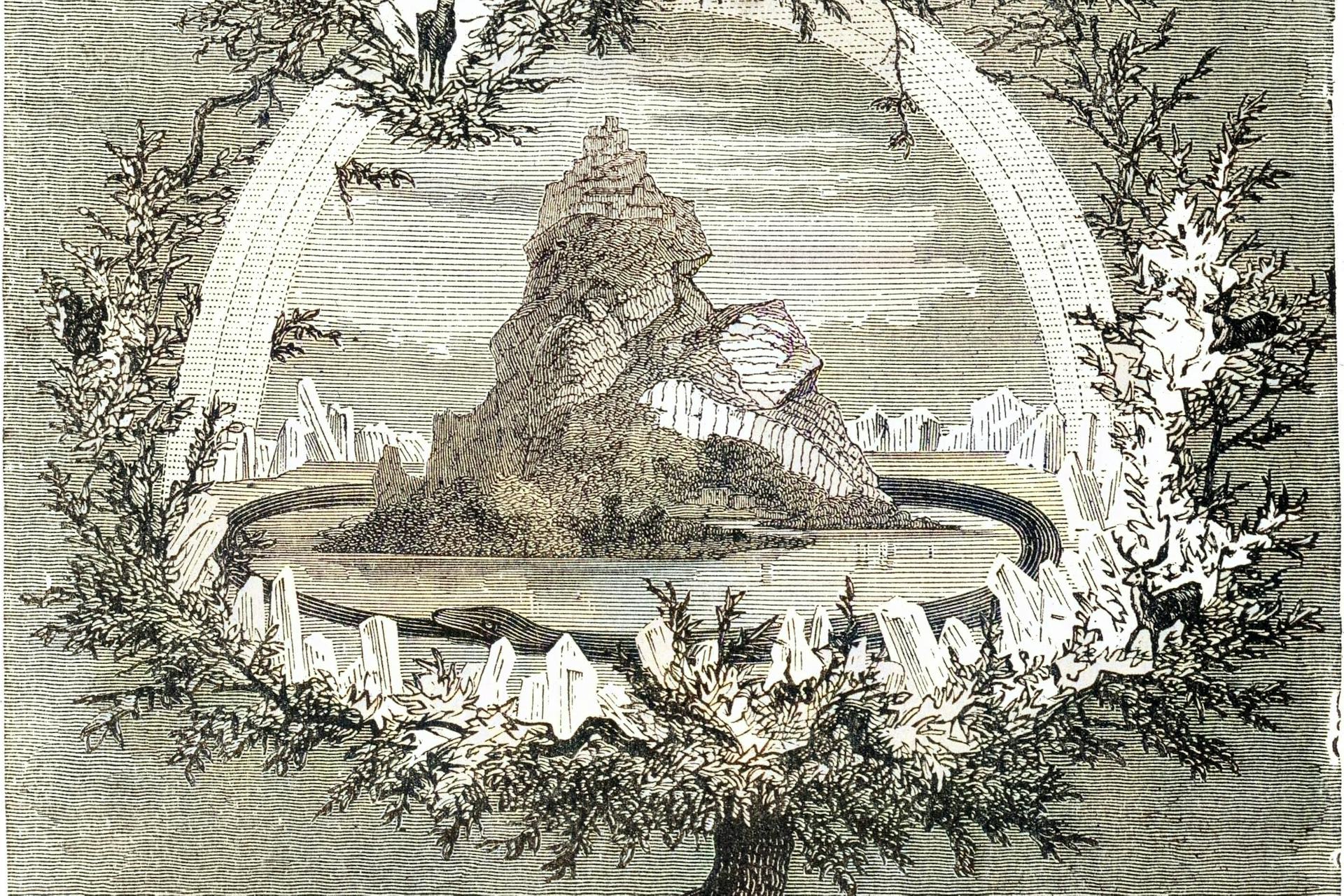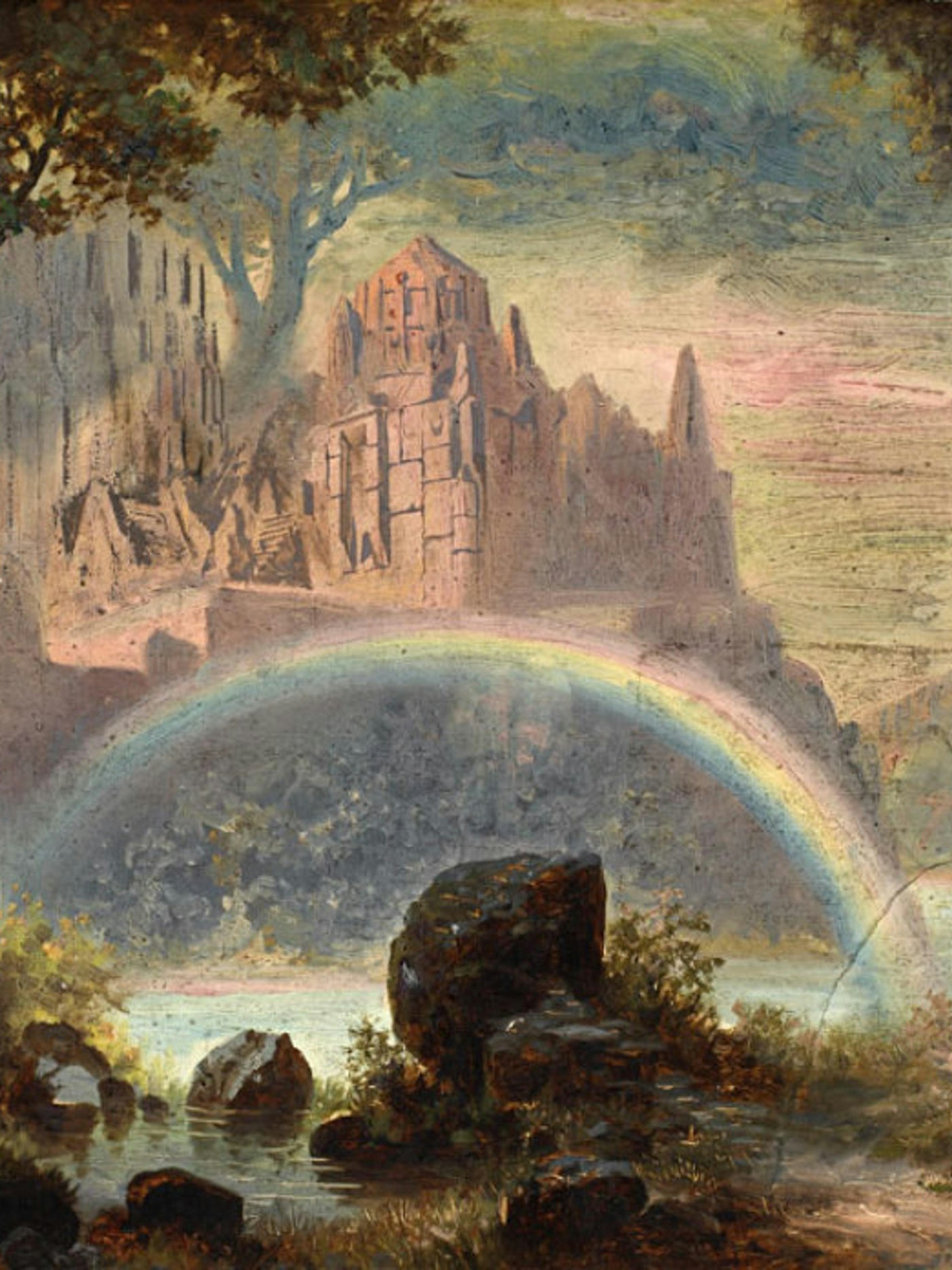Nine Realms

Etching of the mythical world tree Yggdrasil, from which the Nine Realms grew.
Chroma CollectionAlamyOverview
According to Norse cosmology, the known universe was composed of Nine Realms. These realms were Asgard, the near-perfect home of the Aesir deities; Jotunheim, the fallen world of the monstrous jötunn; Midgard, the land of humans; Alfheim, home of the elves; Hel, a resting place for the dead; Vanaheim, the world of the magical Vanir deities; Nidavellir, the subterranean realm of the dwarves; Niflheim, a frigid land of ice and snow; and Muspelheim, a realm of heat and flame.
List of the Nine Norse Realms
The Nine Realms hung on the branches, or else grew from the roots and bole of Yggdrasil, the world tree, which gave structure and form to the cosmos. Their position within Yggdrasil determined both their core characteristics and their connections to other realms. Though the realms were distinct from one another, their boundaries were surprisingly porous. Intrepid travelers, both mortal and divine, could and did traverse the liminal spaces between worlds. Asgard and Midgard were connected via the great rainbow bridge known as the Bifrost, making it possible for deities to influence the humans who adored and abhorred them in equal measure.
Mythology, Part I: Origins
Creation
According to Norse creation myths, the yawning void called Ginnungagap once dominated all creation. During this embryonic stage, the universe held just two realms: Muspelheim, the primordial realm of heat and flame, and Niflheim, the primordial realm of cold and frost. As time wore on, the two opposing worlds encroached upon one another, until the fires of Muspelheim began to melt Niflheim’s frost. The vapors coalesced into cruel Ymir, the first of the giants. The melting ice also revealed Audumla, a cow who nursed Ymir and fed on the salty ice.
Audumla’s voracious licking eventually revealed Buri, the progenitor of the Aesir tribe and grandfather of Odin. Buri’s children would ultimately go on to slay the cruel Ymir. His lifeless body became the building material for other realms, which the young gods built in the midst of Ginnungagap:
‘They took Ymir and bore him into the middle of the Yawning Void, and made of him the earth: of his blood the sea and the waters; the land was made of his flesh, and the crags of his bones; gravel and stones they fashioned from his teeth and his grinders and from those bones that were broken . . . Of the blood, which ran and welled forth freely out of his wounds, they made the sea . . . They took his skull also, and made of it the heaven, and set it up over the earth with four corners; and under each corner they set a dwarf: the names of these are East, West, North, and South. Then they took the glowing embers and sparks that burst forth and had been cast out of Múspellheim, and set them in the midst of the Yawning Void, in the heaven, both above and below, to illumine heaven and earth.’[1]
Yggdrasil
During this time, the mighty ash tree Yggdrasil grew amidst creation and connected the Nine Realms. Though the architecture of the tree and the locations of its realms remain shrouded in mystery, Snorri Sturluson’s Gylfaginning offers some clues:
‘The Ash is greatest of all trees and best: its limbs spread out over all the world and stand above heaven. Three roots of the tree uphold it and stand exceeding broad: one is among the Æsir; another among the Rime-Giants, in that place where aforetime was the Yawning Void; the third stands over Niflheim.’[2]
This passage indicates that the roots of Yggdrasil extended into the realm of the Aesir (Asgard), as well as Jotunheim, the world of the giants, and frozen Niflheim. The location of the other realms remains the subject of considerable debate.
Mythology, Part II: The Nine Realms
Asgard
The realm of the Aesir gods, Asgard approached the civilized perfection of the wise and powerful gods who ruled it. As king of the gods, Odin held court in Valhalla, the realm’s great hall. Valhalla served as the resting place for the souls of half of all fallen warriors. The other half went to Folkvangr, a field or meadow in Asgard, where Freya kept her abode. Despite its near perfect state, Asgard still saw trouble from time to time. Much of Asgard was damaged or destroyed in the Aesir-Vanir War. Even in peaceful times, enemies continued to penetrate its boundaries and cause mischief.
The power of Asgard extended throughout the Nine Realms. A central tenet of Norse religion was the notion that the Asgardians cared for—and sometimes antagonized—the people of Midgard. The rainbow Bifrost connected the two realms, allowing gods such as Thor and Loki easy access to the mortal realm. The Asgardians also contended with the monstrous inhabitants of Jotunheim, whom they loathed for being antithetical to them in every way. Incursions into Jotunheim appeared frequently in Norse myth, and almost always ended in Asgardian victory.
Jotunheim
Jotunheim (“home of the jötunn”) was the opposite of Asgard in every regard. Whereas Asgard enjoyed the peace and prosperity associated with law and order, Jotunheim was consumed by the chaos and conflict wrought by its lawless inhabitants, which included giants and trolls (among others). The realm was dominated by the fortress called Utgard, literally “beyond the fence,” a reference to its position outside the civilized order (or innangard).
Jotunheim was a common backdrop for the ongoing feuds between the Aesir and the jötunn. Tales of divine heroes journeying to Jotunheim to foil jötunn plots were common in Norse mythology.
Midgard
The “middle enclosure,” Midgard was the realm of humanity. Not as civilized as Asgard, nor as barbarous as Jotunheim, Midgard fell somewhere inbetween. While the people of Midgard would always strive to achieve the stable perfection of Asgard, they would never achieve it due to their natural fallibility.
Midgard was surrounded by an ocean, which was patrolled by Jörmungandr, a monstrous sea serpent fathered by Loki. Holding its tail in its mouth, the World Serpent encircled the entire realm. Midgard was connected to Asgard via the Bifrost, a rainbow bridge that could be used by deities and mortals alike.
During Ragnarök—a series of events prophesied to bring about the destruction of the world—Midgard was fated to host a great battle between Jörmungandr and Thor, the “warder of earth.” Per the Völuspá, of the Poetic Edda:
Against the serpent goes Othin’s son.
In anger smites the warder of earth,— Forth from their homes must all men flee;- Nine paces fares the son of Fjorgyn, And, slain by the serpent, fearless he sinks.[3]
Muspelheim
The molten realm of heat and flame, Muspelheim was one of two realms that existed at the dawn of time. In Norse creation myths, Muspelheim’s fires melted the ice of Niflheim. The ensuing water droplets formed Ymir, the first giant, and the receding glaciers revealed Buri, the progenitor of the Aesir tribe. During Ragnarök, the fires of Muspelheim would consume the world. Sturluson described this prophetic scene in his Gylfaginning:
In this din shall the heaven be cloven, and the Sons of Múspell ride thence: Surtr shall ride first, and both before him and after him burning fire; his sword is exceeding good: from it radiance shines brighter than from the sun; when they ride over Bifröst, then the bridge shall break, as has been told before. The Sons of Múspell shall go forth to that field which is called Vígrídr, thither shall come Fenris-Wolf also and the Midgard Serpent; then Loki and Hrymr shall come there also, and with him all the Rime-Giants. All the champions of Hel follow Loki; and the Sons of Múspell shall have a company by themselves, and it shall be very bright.[4]
Niflheim
One of the most ancient realms in existence, Niflheim was a realm of ice and snow. After the realm began to thaw from exposure to Muspelheim, its icy waters gave form to Ymir, the first giant. When its glaciers melted in the face of the molten heat, it exposed Audumla, the cow that nursed Ymir, and Buri, the first of the Aesir gods, who was frozen within Niflheim’s glaciers. Cold and inhospitable, Niflheim was seldom visited by gods or mortals.
Vanaheim
Vanaheim was the mysterious home of the Vanir deities, known for their command of magic and divination. Because the realm is mentioned only once in the entirety of Norse myth, little is known about it. In a poem called the Vafþrúðnismál of the Poetic Edda, Odin, disguised as a traveler, claimed Njord was born in the “home of the Vanir,” or Vanaheimr. Due to its obscurity, almost nothing can be said with any certainty about Vanaheim.
Alfheim
Alfheim (“home of the elves”) was the land of the luminous Ljósálfar, or “Light Elves,” and the jet-black Dökkálfar, or “Dark Elves.” Alfheim seldom appears in surviving texts. That Alfheim was ruled by the Vanir deity Freyr suggests an intimate connection between the mysterious elves and the magical Vanir.
Nidavellir
Nidavellir (meaning “the fields of the new moon” or perhaps “the dark fields”) was a subterranean realm, rich in ores and metals and minerals, inhabited by the dwarves. As its name suggests, Nidavellir was a dark and craggy realm, said to be located somewhere in the “north,” presumably in regard to its location on Yggdrasil. Nidavellir is sometimes referred to as Svartalfheim, meaning “home of the black elves.”
Nidavellir was best known for the craftsmanship of its inhabitants: dwarves who specialized in all branches of metallurgy and jewelry-making. Some of the best-known items in Norse mythology came from Nidavellir, including Skidbladnir, an unsinkable ship; Gungnir, a deadly spear; and Mjölnir, Thor’s legendary hammer.
Hel
Another subterranean region located in the mythological “north,” Hel was the dwelling place of the departed souls and the site of the Norse afterlife. Surrounded by a river that gave off the sound of clanging swords, as well as a massive wall, the realm of Hel was ruled by the goddess of the same name. While Hel (the realm) was not a place of overt punishment or torture, it was nevertheless a bleak place that mortals feared to tread.
Pop Culture
The Nine Realms make regular appearances in popular culture, though they are generally discussed individually. The Nine Realms are mentioned in passing in the film Thor (2011), and appear as part of a constellation (which naturally takes the shape of the world tree Yggdrasil). The Realms are also discussed in the film’s sequels.



